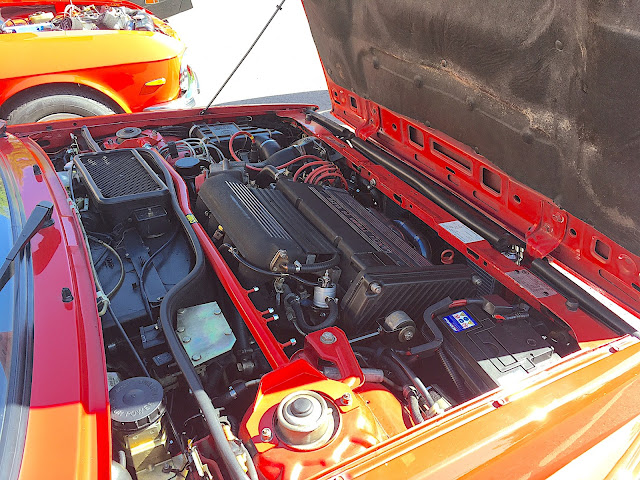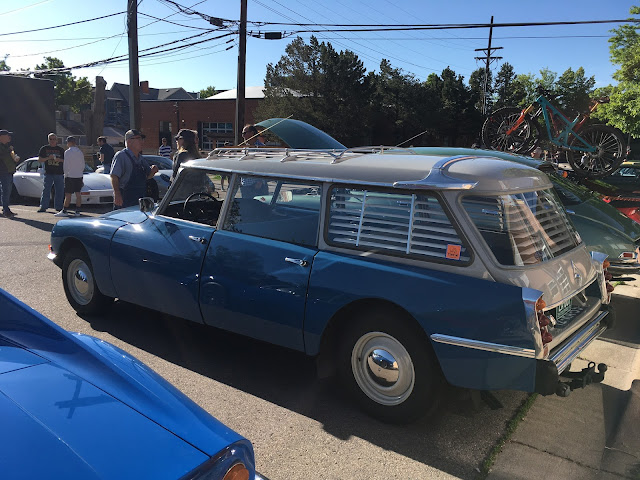This Noble M400 was a new face at the Sunday Classics & Coffee event in Boulder. It was designed by the British Noble firm, which had once made Ferrari P3 replicas, but production was outsourced to Hi-Tech Automotive in Port Elizabeth, South Africa. Weight, around 2340 pounds, was close to that of the original Mazda Miata, but power was lots higher. 425 hp. from the Roush-modified twin-turbo 3 liter Ford Duratec V6 was directed to the rear wheels through a 6-speed manual transaxle. At least 75 cars were built from 2006 to 2007.
Today's McLaren, shown above in go-fast red, weighs about 1,000 lb. more than the Noble, but makes 720hp in 720S version to 750 hp in the 750S from a twin-turobcharged 4.0 liter V8. Zero-to 60 comes up in 2.8 seconds. Ferrari's 246GT Dino (1968-'73) shown below was a pioneer of the mid-engine configuration shared by the McLaren...
But in the Dino the 2.4 liter 65-degree V6 was mounted tranversely behind the cockpit and sent 195 hp to the rear wheels through a 5-speed transaxle. Bodywork was by Pininfarina.
The modern Alfa Romeo 4C below, produced from 2013 to 2020, produced its power from a mid-mounted 1750cc turbocharged inline 16-valve four routing its 240 horsepower through a 6-speed transaxle with paddle shifts on the steering wheel.
The Lotus Sprint was called the Eclat in Euorpe, this holding to Colin Chapman's policy of naming his creations with the letter "E" (Elite, Elan, Esprit etc.) because he'd like the sound of Lotus Eleven. Produced from 1976-'82, the Sprint was a fastback version of the wagon-back Type 75 Elite. Both used the 16-valve, 2 liter Lotus twincam engine. They were, at the time, the most expensive four-cylinder cars, which spelled failure in the US market. Oddly, rear brakes were inboard-mounted but reverted to drums, an apparent cost-saving move...
Last month's winner of our informal Best of Show award, the 1972 Lancia Fulvia 1600 HF, was joined by another famous (in Europe anyway) Lancia rally car, the Delta Integrale (1986-94) in the foreground.
The cars are a study in contrasting approaches to rally car design by a firm that seemed to be guided by its engineers rather than its accounting department. The Fulvia engine, below, was a narrow-angle twin-cam aluminum V4 of 1.6 liters driving the front wheels...
The turbocharged engine of the Delta Integrale was a 16-valve twincam inline four of the same size (eventually available in 2..0 liters), transversely mounted but driving all four wheels by using a torque-sensing center differential. Both cars scored major successes in international rally competition.
Two Alfa Romeo Berlinas designed in the Sixties showed up, a white TI model from 1968 and a red Giulia from 1970. Engine offered in the US were the 1600cc all-aluminum twincam six based on the 1300cc Giulietta. Ironically, owing to US emissions regulations, those were two years when Alfas were not imported Stateside...
The Alfa Milano below was offered in the US from 1986-'89. It was based upon the Model 75, and offered American drivers the experience of driving a sedan powered by a modern 3 liter, 60 degree overhead cam V6 with a 5 speed transaxle. Long before BMW coined the slogan "The Ultimate Driving Machine", Italian manufacturers creating the sports sedan niche, Alfa with the twin-cam 1900, Giulietta and Giulia, and Lancia with the V6 Aurelia transaxle cars. Here the Alfa provides company to a BMW 3 Series comvertible from the same era.
Healey historian and restorer Roger Moment's 1955 Austin-Healey 100 BN1 series (the first Austin-Healey) provides company to his friend John's Austin-Healey 100-6. Mr. Moment was able to provide a tutorial on the differences between BN1 and the BN2 that appeared in 1956, and also on the 100-6 that was produced from 1956 to '59. The BN1 and BN2 series featured a 2660cc liter inline four (the BN1 with 3 speeds, the BN2 with 4), while the 100-6 featured a 2639cc inline 6 and 2 inches more of wheelbase at 92 inches. All engines featured overhead valves. In return for the smoother six cylinder power, the 100-6 lost the charming fold-down windshield of the BN1 and BN2...
A Citroen ID Series wagon joined its sister car, a DS-21 on 8th St. Both cars feature overhead valve inline four cylinder engines driving the front wheels...
Both cars also feature the self-levelling hydropneumatic syspension system that made Citroen famous upon its introduction at the Paris Auto Salon in 1955. As Kevin Roberts' green DS21 sedan from 1972 demonstrates, the ride height was adjustable from a low, ground-hugging highway cruising mode to maximum ground clearance for unpaved roads. The ID wagon has a manual 4-speed transaxle, while the DS has a 3-speed automatic. Power steering was an option on the ID, but standard on the DS.
AIr-cooled Porsche 911s flank an Alfa Romeo 1750 GTV, offered by the Milanese firm from 1967 to `72. Porsche abandoned its chrome bumper style to comply with US bumper laws for the 1974 model year. Alfa Romeo managed to keep the chrome bumpers on the GTV until its final year in the US (1974) by fitting small bumper guards and claiming the car was a 2 passenger…the rear seats on the '74 cars were fitted with a sign that they were not to be occupied when the car was in motion. Admirers of the earlier chrome-bumper 911 may wonder why Porsche didn't try this...
The lineup along the east side of 8th St. included a Porsche 912 from the '66-'67 period, a Volvo P1800 coupe from the same era, a 21st century Alfa Romeo 4c, a round tail light BMW 2002 that scored BMW's first success in the US market in the late 60s, and a bright green Mini from the era when Minis were built by BMC instead of BMW...
The Series 2 E-type was Jaguar's attempt to make their 2-seater into a more practical car. Improvements included a bigger air intake and radiator with twin multi-blade fans, upgrading the already powerful 4-wheel disc brakes, and adding bigger parking and tail lights. Not all improvements were greeting with joy by industrial designer types, though...
Ted Ax of Ax & Allies, Denver specialists in repair of vintage British machinery and for some reason Citroens too, brought this righthand-drive MGB from the golden age of that car and of British cars in general (the Sixties). The car was kitted out with full rally regalia...
Parked next to the Ax MGB was a Series I E-type Jag that, if both car and driver make it to August 2023, the author will have had for 50 years. Good heavens, that's half a century...
Overall, a memorable show on Memorial Day weekend. Ace the Labrador pup gave it a fast wag of approval...
Photo Credits:
All photos are by the author.


























































